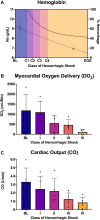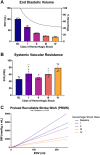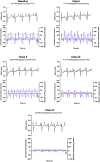Class of hemorrhagic shock is associated with progressive diastolic coronary flow reversal and diminished left ventricular function
- PMID: 36589436
- PMCID: PMC9795012
- DOI: 10.3389/fphys.2022.1033784
Class of hemorrhagic shock is associated with progressive diastolic coronary flow reversal and diminished left ventricular function
Abstract
Introduction: The relationship between coronary artery flow and left ventricular (LV) function during hemorrhagic shock remains unknown. The aim of this study was to quantify coronary artery flow directionality alongside left ventricular function through the four classes of hemorrhage shock. Methods: Following baseline data collection, swine were exsanguinated into cardiac arrest via the femoral artery using a logarithmic bleed, taking each animal through the four classes of hemorrhagic shock based on percent bleed (class I: 15%; class II: 15%-30%; class III: 30%-40%; class IV: >40%). Telemetry data, left ventricular pressure-volume loops, and left anterior descending artery flow tracings over numerous cardiac cycles were collected and analyzed for each animal throughout. Results: Five male swine (mean 72 ± 12 kg) were successfully exsanguinated into cardiac arrest. Mean left ventricular end-diastolic volume, end-diastolic pressure, and stroke work decreased as the hemorrhagic shock class progressed (p < 0.001). The proportion of diastole spent with retrograde coronary flow was also associated with class of hemorrhagic shock (mean 5.6% of diastole in baseline, to 63.9% of diastole in class IV; p < 0.0001), worsening at each class from baseline through class IV. Preload recruitable stroke work (PRSW) decreased significantly in classes II through IV (p < 0.001). Systemic Vascular Resistance (SVR) is associated with class of hemorrhage shock (p < 0.001). Conclusion: With progressive classes of hemorrhagic shock left ventricular function progressively decreased, and the coronary arteries spent a greater proportion of diastole in retrograde flow, with progressively more negative total coronary flow. Preload recruitable stroke work, a load-independent measure of inotropy, also worsened in severe hemorrhagic shock, indicating the mechanism extends beyond the drop in preload and afterload alone.
Keywords: coronary artery flow; exsanguination cardiac arrest; hemorrhagic shock; left ventricular function (LV function); pressure-volume (P-V) loop.
Copyright © 2022 Elansary, Stonko, Treffalls, Abdou, Madurska and Morrison.
Conflict of interest statement
DS has received payments from Catalio Capital Management, LP for investment advising unrelated to this work. The remaining authors declare that the research was conducted in the absence of any commercial or financial relationships that could be construed as a potential conflict of interest.
Figures






Similar articles
-
Diaspirin cross-linked hemoglobin fails to improve left ventricular diastolic function after fluid resuscitation from hemorrhagic shock.Eur Surg Res. 2001 Sep-Dec;33(5-6):318-26. doi: 10.1159/000049725. Eur Surg Res. 2001. PMID: 11805391
-
The Underlying Cardiovascular Mechanisms of Resuscitation and Injury of REBOA and Partial REBOA.Front Physiol. 2022 May 9;13:871073. doi: 10.3389/fphys.2022.871073. eCollection 2022. Front Physiol. 2022. PMID: 35615678 Free PMC article.
-
Echocardiographic and hemodynamic indexes of left ventricular preload in patients with normal and abnormal ventricular function.Anesthesiology. 1994 Aug;81(2):376-87. doi: 10.1097/00000542-199408000-00016. Anesthesiology. 1994. PMID: 8053588
-
Electrocardiogram-synchronized pulsatile extracorporeal life support preserves left ventricular function and coronary flow in a porcine model of cardiogenic shock.PLoS One. 2018 Apr 24;13(4):e0196321. doi: 10.1371/journal.pone.0196321. eCollection 2018. PLoS One. 2018. PMID: 29689088 Free PMC article.
-
The Cardiac Physiology Underpinning Exsanguination Cardiac Arrest: Targets for Endovascular Resuscitation.Shock. 2021 Jan 1;55(1):83-89. doi: 10.1097/SHK.0000000000001607. Shock. 2021. PMID: 33337788
Cited by
-
A comprehensive overview of fixed-volume hemorrhage effects in New Zealand White rabbit models.Open Vet J. 2025 Mar;15(3):1253-1263. doi: 10.5455/OVJ.2025.v15.i3.17. Epub 2025 Mar 31. Open Vet J. 2025. PMID: 40276174 Free PMC article.
-
Inhibition of integrin alpha v/beta 5 mitigates the protective effect induced by irisin in hemorrhage.Exp Mol Pathol. 2023 Dec;134:104869. doi: 10.1016/j.yexmp.2023.104869. Epub 2023 Sep 27. Exp Mol Pathol. 2023. PMID: 37690529 Free PMC article.
-
Investigating the variability in pressure-volume relationships during hemorrhage and aortic occlusion.Front Cardiovasc Med. 2023 Aug 23;10:1171904. doi: 10.3389/fcvm.2023.1171904. eCollection 2023. Front Cardiovasc Med. 2023. PMID: 37680564 Free PMC article.
-
Technical and analytical approach to biventricular pressure-volume loops in swine including a completely endovascular, percutaneous closed-chest large animal model.JVS Vasc Sci. 2024 Jan 17;5:100190. doi: 10.1016/j.jvssci.2024.100190. eCollection 2024. JVS Vasc Sci. 2024. PMID: 38486870 Free PMC article.
-
High flow cooled air can decrease brain temperature without injuring the snout or brain in Swine.Surg Pract Sci. 2022 Dec 28;12:100154. doi: 10.1016/j.sipas.2022.100154. eCollection 2023 Mar. Surg Pract Sci. 2022. PMID: 39845302 Free PMC article.
References
-
- Barnard E. B. G., Manning J. E., Smith J. E., Rall J. M., Cox J. M., Ross J. D. (2017). “A comparison of selective aortic arch perfusion and resuscitative endovascular balloon occlusion of the aorta for the management of hemorrhage-induced traumatic cardiac arrest: translational model in large swine,”. Editor Brohi K., 14, e1002349.PLOS Med.7 - PMC - PubMed
LinkOut - more resources
Full Text Sources

